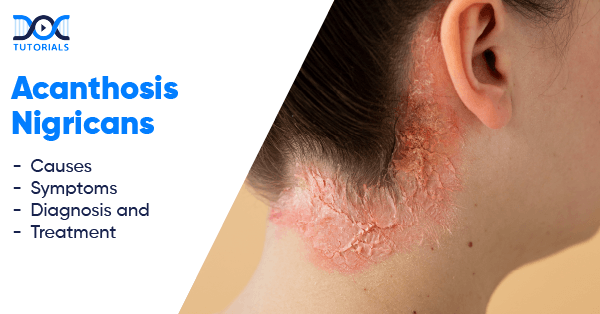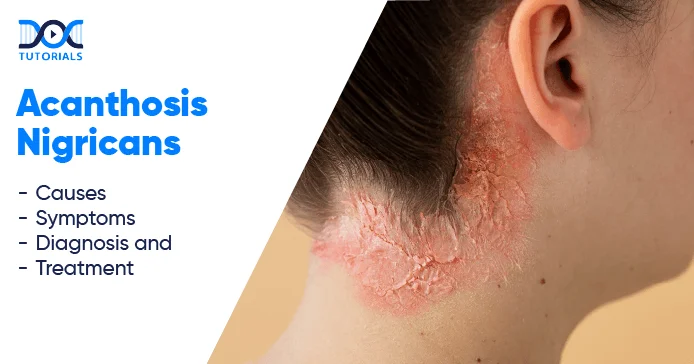Acanthosis Nigricans: Causes, Symptoms, Diagnosis, and Treatment

Acanthosis nigricans develops most frequently in people who have metabolic diseases, either endocrine system disharmony or cancerous conditions. It is characterised by hyperpigmented and velvety patches on the skin and can affect individuals of all races, ethnicities and age groups.
Learning about this condition is crucial for detecting underlying health issues at an early stage and opting for proper treatment. In addition, it is beneficial for MBBS or NEET PG aspirants to learn about this topic for their respective academic courses.
This guide delves into the causes, symptoms, diagnostic approaches, and treatment options for acanthosis nigricans.
What is Acanthosis Nigricans?
The skin condition, acanthosis nigricans, produces dark areas along with skin thickening. It appears in specific body regions and results in a velvety skin texture, which is one of the major characteristics of this medical condition.
When acanthosis nigricans affects a person, they usually assume their skin developed dark patches because of contact with external substances like dyes. The colour of the darkened area does not get removed when people attempt to clean it by washing. Although this condition is not harmful and non-infectious, it indicates an underlying health issue that needs medical attention.
What are the Causes of Acanthosis Nigricans?
Some of the most common acanthosis nigricans causes are as follows:
- Insulin Resistance
It is the leading cause of acanthosis nigricans. When the body becomes resistant to insulin, it struggles to regulate blood sugar levels properly. This condition is closely linked to type 2 diabetes and polycystic ovarian syndrome (PCOS), both of which may contribute to the development of acanthosis nigricans.
- Medications and Supplements
Certain drugs can trigger this skin condition. These include high doses of niacin, oral contraceptives, anti-inflammatory medications like prednisone, and some corticosteroids.
- Hormonal Imbalances
Conditions like hypothyroidism, polycystic ovary syndrome (PCOS), and Addison’s disease can disrupt hormone levels, increasing the likelihood of developing this skin condition.
- Underlying Health Conditions
Acanthosis nigricans may also be linked to serious medical conditions such as lymphoma, gastric carcinoma, and other cancers affecting the colon and liver.
- Cancer
In rare cases, this condition can be a sign of an internal malignancy, particularly cancers of the stomach, liver, or colon. When associated with cancer, it tends to develop suddenly and spread rapidly.
- Autoimmune Disorders
Conditions like Sjogren’s syndrome, lupus, and scleroderma can also be associated with the development of acanthosis nigricans.
What are the Risk Factors of Acanthosis Nigricans?
Several factors can increase the chances of developing acanthosis nigricans, such as:
- Obesity
Excess body weight is one of the strongest risk factors. The higher a person’s weight, the greater their chances of developing this skin condition.
- Ethnicity
Research suggests that certain racial groups are more prone to acanthosis nigricans. In the United States, it is more commonly observed among Native Americans.
- Genetics
In some cases, acanthosis nigricans runs in families. If close relatives have experienced this condition, there may be a genetic predisposition to developing it.
What are the Symptoms of Acanthosis Nigricans?
Acanthosis nigricans symptoms are easy to recognise due to their distinct appearance. The most noticeable sign is the presence of dark, thickened patches of skin with a velvety texture. These patches typically develop in areas where the skin folds, such as:
- Neck
One of the most common spots, often forming dark rings or lines, especially on the back of the neck.
- Elbows, Knees, and Knuckles
These joints may show thickened, darkened skin over time.
- Armpits
Noticeable dark patches may develop in this area.
- Face and Hands
Though less common, some people may notice changes in the skin on their face or palms.
- Under the Breasts
Skin folds beneath the breasts are prone to these changes.
- Groin
The inner thighs and groin region are frequently affected, particularly in individuals with excess weight.
Following are some additional symptoms of acanthosis nigricans:
- Apart from discolouration, some individuals may experience itchiness, dry patches, or even skin tags.
- In rare cases, the affected areas might emit an unpleasant odour.
These symptoms typically appear gradually, starting with subtle changes in skin tone and texture before becoming more prominent.
It is important to note that acanthosis nigricans is not a disease on its own but a sign of an underlying condition, such as diabetes or hormonal imbalances. If you notice these skin changes, seeking medical advice is crucial for identifying and addressing the root cause.
How is Acanthosis Nigricans Diagnosed?
Diagnosing acanthosis nigricans is usually simple due to its distinct skin changes. A doctor or dermatologist can often recognise it through a physical examination. However, to determine the underlying cause, additional tests may be required:
- Blood Tests
These help detect high insulin levels, abnormal glucose levels, or other indicators of insulin resistance and diabetes.
- Skin Biopsy
Though rare, a small sample of the affected skin may be taken and analysed under a microscope if the diagnosis is uncertain.
- Hormone Testing
If a hormonal disorder is suspected, tests may be conducted to assess thyroid function, cortisol levels, or reproductive hormones.
- Cancer Screening
If malignant acanthosis nigricans is a possibility, doctors may recommend imaging scans or endoscopic procedures to check for internal cancers.
Early diagnosis is crucial, as this condition can be a sign of an underlying health issue that needs immediate medical attention.
What are the Treatment Options for Acanthosis Nigricans?
While acanthosis nigricans itself has no direct cure, managing its underlying cause can lead to significant improvement. As a result, acanthosis nigricans treatment approaches focus on two key areas:
- Managing the Symptoms
- Topical Treatments: Creams containing ingredients like retinoids, hydroquinone, and salicylic acid may help lighten darkened skin and improve texture. In some cases, acanthosis nigricans laser treatment can reduce skin thickening.
- Keratolytics: These exfoliating agents help remove dead skin cells, making the affected areas appear smoother and less pigmented.
- Cosmetic Procedures: Treatments like chemical peels, dermabrasion, and laser therapy can enhance the skin’s appearance by reducing discolouration and roughness.
- Addressing the Underlying Cause
- Weight Loss: Shedding excess weight can lower insulin levels and significantly improve skin symptoms in cases where obesity is a contributing factor.
- Blood Sugar Control: For individuals with diabetes or insulin resistance, lifestyle changes, medications, and regular monitoring can help regulate blood sugar and prevent further skin changes.
- Medication Adjustments: If certain drugs trigger the condition, a doctor may suggest modifying or discontinuing them under medical supervision.
- Cancer Treatment: When acanthosis nigricans is linked to an internal malignancy, treating the cancer through surgery, chemotherapy, or radiation may lead to skin improvement.
Early diagnosis and targeted treatment can make a noticeable difference in managing acanthosis nigricans effectively.
FAQs About Acanthosis Nigricans
- Is acanthosis nigricans harmful?
While the condition itself is not dangerous, it can indicate an underlying health issue that requires medical attention. If you notice unusual skin darkening or thickening, it is best to consult a doctor or dermatologist for proper evaluation.
- Can acanthosis nigricans be treated at home?
Some home remedies, like gentle exfoliation, regular moisturising, and maintaining a healthy diet, might help improve skin texture. Nevertheless, you must consult a healthcare professional for proper diagnosis and treatment.
- Is acanthosis nigricans linked to other health issues?
Yes, this condition is often associated with insulin resistance, diabetes, polycystic ovary syndrome (PCOS), and in some cases, even certain types of cancer.
- Can children develop acanthosis nigricans?
Yes, children can also develop acanthosis nigricans, especially if they have obesity or a genetic predisposition to insulin resistance. Encouraging a healthy lifestyle early on can help manage and reduce the risk of worsening symptoms.
- Can you reverse acanthosis nigricans?
With proper treatment, significant improvement is possible. Many people see their skin clear up, though some discolouration may still remain.
Conclusion
Acanthosis nigricans is more than a skin condition—it often signals underlying health issues like insulin resistance, diabetes, or hormonal imbalances. While treatments can improve skin appearance, addressing the root cause is key to long-term management. In addition, early diagnosis can help one control the condition effectively.
For medical aspirants, DocTutorials covers several other topics, along with offering NEET PG courses, question banks, top-quality video lectures, mock tests, mentorship, and more. Power up your academic journey by enrolling in our courses today!
Latest Blogs
-

NEET PG Exam 2025- Date, Pattern, Marking Scheme, Subject Wise Weightage, and Exam Mode
NEET PG Exam 2025 is the ultimate gateway for medical graduates aspiring to pursue postgraduate courses in medicine, including MD,…
-

INI CET Exam 2025: Your Roadmap to Success – Key Topics, Strategies, and Lessons from Last Year’s Papers
The INI CET exam is more than just a test; it’s a significant milestone for many medical students aiming to…
-

INI CET Exam Success: Previous Year Question Papers & Ultimate Guide – INI CET PYQ
One can feel overwhelmed while preparing for the INI CET (Institute of National Importance Combined Entrance Test). A vast syllabus,…





